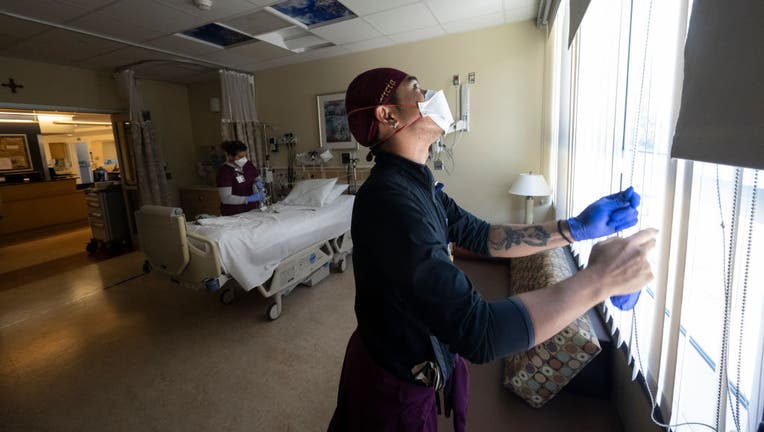CDC says universal masking no longer recommended inside some hospitals, nursing homes

FILE - Nurse assistants prepare a room at Providence St. Joseph Hospital in Orange, California, on April 14, 2022. (Photo by Paul Bersebach/MediaNews Group/Orange County Register via Getty Images)
The U.S. Centers for Disease Control and Prevention has eased its universal masking recommendation in health care settings, unless the facilities are located in areas of high COVID-19 transmission.
The new guidance, which includes hospitals and nursing homes, was part of the CDC’s updated recommendations published on Friday. It marks a major change from its previous recommendation of universal masking.
"This interim guidance has been updated based on currently available information about COVID-19 and the current situation in the United States. Updates were made to reflect the high levels of vaccine-and infection-induced immunity and the availability of effective treatments and prevention tools," the CDC stated.
"Community transmission" is a CDC metric used to describe the amount of COVID-19 spread within each county, which health care facilities use to determine their infection control interventions. This is different from the "COVID-19 Community Levels" metric that the CDC uses to guide non-healthcare settings, such as restaurants. That metric measures the impact of COVID-19 in terms of hospitalizations and healthcare system strain, while also accounting for transmission in the community.
RELATED: Pfizer asks FDA to approve omicron COVID-19 booster shots for 5- to 11-year-olds
The new recommendations offer a framework for health care facilities to implement prevention practices based on their local COVID-19 circumstances. When community transmission levels are not high, facilities in those areas can "choose not to require" masking and other preventative measures.
But even if not universally required, the CDC said it still remains recommended for individuals in healthcare settings who have suspected or confirmed COVID-19, had close contact with someone who tested positive, or live/work in an area of the facility experiencing an outbreak. Masking is also recommended when caring for patients "who are moderately to severely immunocompromised."
Still, about 68% of the United States was located in areas of "high" community transmission, according to CDC data on Wednesday. The rest falls under the "substantial," "moderate" or "low" category.
The CDC has been "streamlining" its guidance since August amid a lower risk of severe illness, hospitalization, and death compared to earlier in the pandemic, thanks to vaccines, a better understanding of how to protect people from being exposed, and other tools.
Holly Harmon, senior vice president of the American Health Care Association and the National Center for Assisted Living, praised the new guidance.
"While our commitment to infection prevention and control continues, adapting Covid protocols means recognizing the current stage of this pandemic as well as the importance of quality of life for our nation's seniors," Harmon said in a statement.
Harmon added that after more than two years, "residents will get to see more of their caregivers' smiling faces, and our dedicated staff will get a moment to breathe."
But some questioned the updated recommendations, including Megan Ranney, dean of the Brown University School of Public Health. In a tweet, Ranney expressed concern about how the new guidance means "places with substantial transmission can unmask sick patients who haven’t yet been tested for Covid, right next to the elderly, chemo patients, people with pulmonary disorders, & pregnant women."
Former Surgeon General Jerome Adams also shared concerns on Twitter, writing that CDC is making "a recommendation they know will end masking … while also admitting it's too early to do so."
"This nuanced have your cake and eat it too approach hasn't worked A SINGLE TIME throughout the pandemic," he added. "People hear 'no more masks!'"
RELATED: Should I get the new COVID booster and flu shot at the same time? Your questions, answered
This story was reported from Cincinnati.

